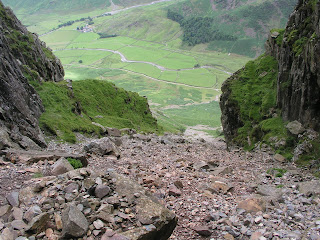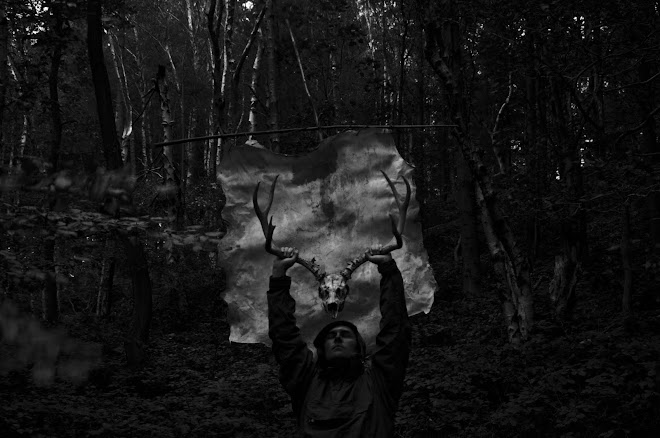skip to main |
skip to sidebar
Neolithic Weekend IV: The Descent




The clock was against me, and though I would have gladly lingered in this place of 45-degree angles and trickling water to ponder the lives of those people who first climbed up – or down – to the site, I had to be back to the car to be on my way to the Woodsmoke rendezvous for 4.30. It was then that I made a descision that was to commit me for the rest of the afternoon – to climb back up the chute and go back down the way I came or to take the direct route down the scree to the Cumbrian Way below and peg it along the valley bottom.
I’ve never been one for sticking to paths and I do like to go to places that few people have been before so with that I tightened my straps and went down the slope. Let this be a word of advice to anybody else who may wish to experience the grandeur of the Pike O’Stickle axe factory – do not go down the scree slope. I was very conscious that I was in the middle of a scheduled ancient monument and that I should tread as lightly as possible but even so, and keeping to the grass as much as possible, I still got knocks and cuts from the sharp edges of the rocks. My progress was painfully slow, each step worked out so as to cause the minimum disruption to the site and to minimize my chances of breaking my ankle. Eventually I reached the tree line, if three scrubby rowans clinging to the crags can be called a tree line but my troubles were not over yet as several hundred metres of scree lay in front of me and now there really was no way back.
I struggled and sweated downwards and I have never been more happy to see bracken. I left the open scree and made my way down through the deep green bracken jungle, but as the fronds reached to chest height and covered what was basically a steep boulder field it was not exactly plain sailing. I still had visions of having to explain to some angry Mountain Rescue team what the fuck I was doing up there but as I pressed on the slope became less steep, the ground underfoot less rocky and it was with a light heart and a blithe spirit that I walked the last hundred metres across the open grass to the path at the foot of the mountain.
On the walk out to the car I pondered the meaning and the importance of this place. It is obvious that as a source of stone to make axe-heads Great Langdale was a special place to the people of the Neolithic. This was a transitional time that saw nomadic hunter-gatherer bands form into more settled communities of pastoralist and agriculturalists and this process of change would have necessitated the clearance of the woodland that covered the islands. These people would have been skilled timber workers used to building structures and were obviously experienced tool makers. Polished stone axe-heads would have been prized high status possessions that endowed their owners with the ability to extract a living from the land and their distribution across the British Isles and as far a field as Poland and Morocco speaks of their importance.
The sites of axe manufacture in Great Langdale have been called the first industrial landscape in Britain. The tracks that we use to move around the valley and access the fells may well be the same that the people used 5000 years ago, indeed it would be strange if they were not – people always want to take the quickest and easiest routes across the landscape.
A study of stone axe heads from all over England and Wales came up with the surprising discovery that 27% were made of Group VI Langdale Tuff and originated from the sites around the Pikes. A number of the axe heads from Langdale have been found deposited in wet places — marshes, streams, pools. and show no sign of having been used. This may indicate that the axe heads were not intended for practical use and that they had been placed in significant spots as some kind of religious offering or it may show that the tuff is harder than wood! The predilection of archeologists to attach ceremonial significance to things they do not understand is quaint and amusing; Will Lord told me that his father had ground a replica Langdale axe-head from the Group VI tuff and had leant it to an archeologist who wished to undertake a practical experiment to see what damage it sustained from prolonged tree felling. When the head was returned, having been used to cut down dozens of trees and having been attempted to be tested to destruction it was as good as new and showed no chipping or flaking from use. This stuff is not called Tuff by accident.
How many man hours went into polishing a finished axe-head? I asked Will this and he estimated approximately 130 if the roughout was to be worked by hand, although this could be reduced to around 40 if one was prepared to do away with authenticity and use a power grinder with a diamond bit. Why did people put so much time and energy into their tools, when a couple of hours knapping a roughout would produce a head that could be hafted and cut timber? The answer is in efficiency – the roughout may cut wood but it will not do it as well or for as long as the smooth lines of the polished axe-head. The shape of the head, with its elliptical profile, is a very efficient cutting tool - so much so that even after heavy use no signs of wear are visible.
There are deep lessons for us to learn in the history of these ancient axe-heads. Lessons about the relationship between form and function and the skills people once had for sustaining their own life and meeting their own needs, lessons about our relationship with the landscape and how our presence on these islands has been sustainable only through the extraction and processing of minerals and materials, lessons about the need that people have had, seemingly since earliest times, to explore their locations and make sense of their presence. To follow in their footsteps is to ask oneself the same questions and look for the same answers. Some things do not change.






No comments:
Post a Comment